
DISCLAIMER:
This primer was written when Wrenn & Six was in the format. Although Wrenn has been banned, I’m confident this walkthrough of GW Depths is still a great resource for anyone looking to play the deck.
Introduction:
What is Green-White (GW) Depths?
Many players would argue Green-White Depths is a Legacy combo deck, but I would call it a midrange deck that, like Legacy Food Chain, runs a combo finish (the combo finish of choice being Dark Depths & Thespian’s Stage).
Unlike its GB siblings, GW Depths has a toolbox element mimicking that of Legacy Maverick’s. It takes advantage of Green Sun’s Zenith to consistency find heavy hitters and land tutors like Elvish Reclaimer and Knight of the Reliquary, and silver bullets like Gaddock Teeg or Scavenging Ooze to close out matches and shut down opponents’ strategies.
The deck is very resilient, with multiple ways to find the combo (Crop Rotation, Elvish Reclaimer, Knight of the Reliquary, Once Upon a Time*) as well as ways to protect it ( Giver of Runes , Sylvan Safekeeper, Tomik, Distinguished Advokist and Sejiri Steppe). You also have the added advantage of accessing the combo multiple times through Ramunap Excavator.
GW Depths is much less all in and reliant on the combo compared to the GB variants of Depths. With Green Sun’s Zenith and Knight of the Reliquary, you have even more threats that can close the game out in a matter of two or three turns. And with Ramunap Excavator, you also have access to a Wasteland lock, drawing an extra card each turn in grindy matchups with Horizon Canopy and, of course, getting back your combo pieces.
*Once Upon a Time looks to have a found a home in the Turbo GB builds but is still in testing for most GW pilots.
What is a good starting point for picking up GW Depths?
Here’s Sharkcaster_Mage’s (aka. GP winner and pro player Rodrigo Togores) GW Depths list that went 5-0 through a MTGO League. This is a great stock list to use as a starting point for those players who want to build the deck but aren’t too sure where to begin.

For most players, the Mox Diamond are going to be the biggest (financial) barrier to entry. Unfortunately, there aren’t many – if any – options when it comes to budget fill-ins. You could try a deck that plays mana-producing creatures like Noble Hierarch, but then you’re getting closer to just being a mediocre GW Maverick / GW Depths hybrid. If you want to start your Depths career and don’t have access to Mox Diamond, I would say Turbo Depths is a great ‘budget’ option until you find your way financially down the track.
How Does the Dark Depths & Thespian’s Stage combo actually work?


Here’s a quick step-by-step guide to the combo:
-
- Thespian’s Stage is activated targeting Dark Depths.
- If this ability resolves, Thespian’s Stage is now a copy of Dark Depths with no ice counters on it.
Note: Thespian’s Stage doesn’t receive the ice counters because it was already on the battlefield, it did not enter the battlefield, and therefore misses out on receiving the 10 counters. An example of when a land would enter with the counters would be if you played a Vesuva, copying a Dark Depths as it enters the battlefield.
- Because the controller is now the owner of two Legendary Dark Depths, they need to sacrifice one of them. You can now sacrifice the original Dark Depths, leaving the copied version with no counters in play.
- The trigger of the copied version of Dark Depths now goes on the stack as it does not have any counters on it. If this resolves, you now have a 20/20 Marit Lage token and are hopefully about to win the game.
Pro Tip: If your opponent is trying to resolve the steps above and you have access to Wasteland, do not use your Wasteland during step 2 (when your opponent is activating Thespian’s Stage’s ability and targeting Dark Depths). If you Wasteland the Dark Depths in response, your opponent’s Stage fizzes and they get to keep it. What if I told you there is a way to get both lands off the field AND fizzle any chances of a 20/20?
Let’s skip to step 4 above, where our opponent has a Thespian’s Stage that is now a copy of Dark Depths and the triggered ability to check for ice counters goes on the stack. This is the perfect time to Wasteland the Dark Depths, allow the trigger to check for no counters to resolve and… fizzle. There is no longer a Dark Depths to check for counters, so your opponent is now out 2 lands and doesn’t get rewarded with a visit from Marit Lage.
Why does this deck run Giver of Runes over Mother of Runes?
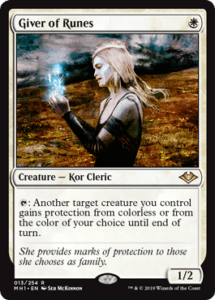

The key reason why GW Depths pilots run Giver of Runes over Mother of Runes is that it allows you to protect your Marit Lage token (and other Legendary creatures) from Karakas, a colourless source. The additional toughness Giver carries also means it survives Wrenn and Six , Plague Engineer and other -x/-1 effects like Liliana, the Last Hope and Golgari Charm. For more interactions check out the list at the end of this primer.
Why does this deck run Path to Exile over Swords to Plowshares?
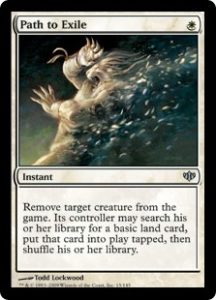

The short answer for Path over Swords to Plowshares is you don’t want to give your opponent an extra turn by extending their life total above 20. You want to be able to make your 1 hit from Marit Lage count and skip the need to play around any sorcery speed removal during your opponent’s following turn (Jace, the Mind Sculptor bounce, Council’s Judgment, Oko an extra drawstep to find removal or untap on a previously tapped
Karakas).
If you’re going to win the game the turn after you cast a Path to Exile, the extra mana source most likely doesn’t mean anything. However, it’s always nice to have an understanding of the decks that do and don’t typically run basic lands, such as RUG Delver / NBC RUG and many Eldrazi variants.
Why play GW Depths over GB Depths?
GW Depths is much better prepared to fight in a meta with Wasteland’s and opposing Dark Depths with the help of Tomik, Distinguished Advokist. Tomik not only keeps your manabase safe by turning off your opponent’s Wastelands, it prevents your Depths opponents from being able to activate their own Thespian’s Stage. Tomik also stops Life from the Loam and, more importantly, Wrenn & Six’s +1 as they both target lands in graveyards.



In my opinion, the black splash and maindeck hand disruption does give you a much better G1 against combo compared to GW, and allows you to clear the way against Swords to Plowshares decks like Miracles. You still have access to Safekeeper and Steppe, but instead of further on-field protection like Giver of Runes and Tomik, you rely on Thoughtseize and Duress to remove their answers before they can interact with your threats. Urborg, Tomb of Yawgmoth is another reason to play GB as it shores up your manabase to make sure you can cast multiple black spells per turn, even with cards like Steppe, Stage, Wasteland, Depths and basic Forest on the field. It’s your best land after the combo pieces and allows you to have Dark Depths and Vampire Hexmage online as early as T2.

Bob Huang, who recently took down an SCG Legacy Classic with the above GB Depths list, isn’t a fan of the GW build, stating in an Everyday Eternal podcast the black cards like Vampire Hexmage are just too strong to drop from the archetype. Hexmage trades with Planeswalkers, nullifies Chalice of the Void and gives you the ability to combo as early as turn 2. You do lack that aggression and power in GW and you may be open to some horrible times against combo without the discard shell, but post-board GW does have a very nice plan against combo. You can find Bob and the guys discussing the deck over at Everyday Eternal around the 01:00:00 mark on their 63rd podcast.
I play GW because it’s more a Maverick deck than a Depths one. It’s also favoured over other Depths decks like Hogaak Depths. Right now I feel it (GW) is more of a metagame advantage. It’s quite good or bad vs the same decks as GB Depths. If you’re a player who likes to play Knight of the Reliquary then it’s better, it just wins you the Depths mirror. – Rodrigo Togores
I also asked Dice, one of the go-to guys of the Lands Discord channel, on his thoughts about the deck right now. I know Dice locally and his love for Dark Depths decks. He’s also quite active in the GW section.
I have found that the main draw of the GW version is your ability to play against a deck that is gunning for Depths. Having a large threat pool with protection grants you longevity and power that the more direct combo builds do not have.
The payoff is that you are not able to threaten someone as fast. Decks that have strong interaction against creatures or decks that can attack your grave directly (Shutting off Reclaimer and Knight’s power gain) can be a mess. This means that the conventional wisdom that white sucks to play against with Lage is not really fixed, but it is mitigated by having the option of wide threats.
Another advantage is having “8” Moxen. GSZ lets you grab a Dryad Arbor early, granting you a lot of consistency for having 3 mana on the second turn. With the meta having slowed down a lot of late, this means you are often dropping power for the current meta threats faster and with a greater consistency than other decks. On top of that, having Elvish Reclaimer and Giver as early plays, you are not often “spinning your wheels” as all your plays demand an answer.
Reclaimer, a card that is in both builds, is just a flat good reason to play Depths. The powerful early game blocking mixed with having his effect be open after a block for either a combat trick or some form of interaction is nice. But the power of GSZ meaning this build has 8 of his really pushes things. Come to think of it, GSZ really is a damn good reason to play this deck.
Why would you play GB over GW Depths?
The reason to play GB is the discard and speed. The power that is granted to you by cutting 6 to 8 discard for ramp and protection leaves you weaker to combo elements in the format. You also lack the ability to push past counters as easily via ripping apart a hand. While this can be mitigated somewhat by running Cavern, sadly the deck has a wide range of creature types and this hampers Cavern as a more wide-reaching tool. The other thing you lose is the power of Hexmage. While Wrenn is everywhere, sometimes the power of using Hexmage for the reason it was printed comes up (stripping a walker of its Loyalty). White lacks this direct answer to walkers that Black has and thanks to one walker being everywhere, this can hurt.
What do you find are the strong and weak matchups for GW Depths?
I find the strongest matches are the more grindy midrange matches. Thanks to your more branching early options (Mox, GSZ, Reclaimer, Giver), you can force reaction that is not predictable. Also, an early threat is often stopped by Reclaimer who can block, then still use his power. Making him far, far stronger than he has any right to be.
I find this means that matches like Delver, Dredge (With “8” Crop Rotations), other Depths decks and the current Hogaak decks are advantageous.
Reanimator often comes down to the hand and the die roll. If you can get a Reclaimer live, you likely win. But that means going first. If not, you need to hold up interaction like Path or Crop rotation and they have discard. I find this match depends on the roll of the die but is not horrid.
F**k Mentor. I have nightmares about that damn deck. Going wide, disposable blockers and the ability to interact with our creatures makes this match hellish at times. They are not as fast as we are, but they have a range and reach we cannot match if they get rolling. This is not a good match. Another is Storm. You can really give them fits if you build your sideboard right but they are not as common of late, so building your sideboard to hate on an uncommon match is not great, then you face them and wish you had. Granted, Veil of Summer is helpful in making this less of a problem than it could have been.
I also reached out to Dom Harvey, an SCG circuit grinder part of Team Nova and a GW Depths pilot. “GW has tools to handle the various combo decks but you can still get run over in Game 1 and then need to pick up both games post-SB (including G3 on the draw). A lot of it depends on what you want to target e.g. Leyline of the Void for Reanimator (which swings that matchup a lot)/Dredge/Hogaak.
I found the Delver matchups to be quite close and had a tough time vs the Tundra decks. I’ve seen several WG lists adopt Cavern of Souls, which improves both matchups considerably – Cavern + Palace Jailer is the best plan vs the UW decks (it’s less reliable vs Stoneblade but they are easier to beat straight up so I think that’s a wash) and Cavern + Knight (with a generally sound manabase) is great vs Delver. The move towards Oko is troubling in the abstract but may actually be better for us in the long run since they can’t afford to run too many 3-drops and TNN was very scary.”
Do you side out Mox Diamond against any specific decks and if so, why?
I find that since we have 8 Moxen, you can side some out quite a bit. I often take one out against the slower matches where making land drops is important and casting a 3-drop on turn 2 is less so. If they have a bolt for your early Knight, you probably don’t want it. When speed is not your major priority, Moxen is less of a must-have.
The times I don’t cut it but it seems counter-intuitive is when I need an early 1. Collector Ouphe. GSZ for Collector is worth having online asap against something like Forge Combo.
I think cutting Diamond is fine vs grindy matchups (UW, 4C) where the card disadvantage matters and you aren’t under pressure to win quickly. – Dom Harvey
So, why play GW over GB?
Resilience, consistency and a strong plan B. As stated above, GW Depths can play extremely well as a midrange deck and doesn’t rely as heavily on the combo as the GB versions do. In the Depths mirror, you’re also the favoured deck thanks to Knight of the Reliquary and your added protection of Tomik, Distinguished Advokist. If you feel you’re going to be facing a large amount of hate locally or online, know GW can shift its gameplan quite easily from attempting to combo off to beating down with some big, fair creatures.
Why would you play GW over Naya Depths?
Naya Depths is a really interesting variant of Depths that takes advantage of Wrenn & Six, however, does not tend to run the Punishing Fire and Grove of the Burnwillows combo like traditional Lands decks do.


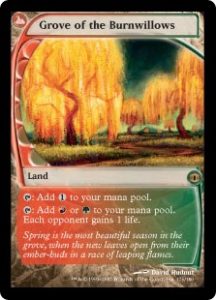
With Naya, you’ll also have access to some nice sideboard cards for blue decks in Red Elemental Blast and/or Pyroblast. “Pyroblast and Red Elemental Blast are only getting better vs these Oko’s” – Matthew Albone, Fair deck advocate.
Here’s an example of a list below that took down 2nd Place at SCG’s Team Open in Philadelphia.

The deck is very good in a fair metagame, but you have to ask yourself why you want to play Naya Depths over 4C Loam. Perhaps it comes down to how good Chalice of the Void is in the metagame, and right now it’s probably at its worst compared to recent metagames. With so much light right now on the Dark Depths combo, 4C Loam seems great as you have a very cool midrange strategy and game against some of the faster decks of the format thanks to Chalice. There are also subtle differences between Naya Depths, Punishing Maverick and 4C Loam but I would say most decisions to play 1 over the other comes down to your knowledge of the metagame.
I tend to agree with Dice (below) on Naya compared to the other variants, but with some well-known players grinding Naya to solid finishes, there is obviously more to the deck than meets the eye. You have a really nice out to problematic perments like True-Name Nemesis or multiple Elves of the same CMC with Blast Zone.
Dice: The reason I do not like the red version is you lose a lot of the power you gain by having this large creature selection. The Naya version is more dependent on the grave, too. What I mean is, sure, you have the Wrenn and the burn, but you lack the density of creatures and you depend more on reloading as a way of protecting yourself (ie. your deck is doing what Lands does already, only you have some board presence). They lack resources like Giver that let you protect your board, and if they stall out, have little that they can do to start over. We suffer from this too, but that density is helpful in mitigating the issue.
What are GW Depths’ bad matchups?
Without hand disruption, you do have a tendency to have a weaker combo and control matchup compared to GB Depths, but your Green Sun’s Zenith package acting as Gaddock Teeg 2-5 does give you some outs to decks like Storm. Against some forms of fast combo, you do also have the G1 out of Crop Rotating into Bojuka Bog to catch your opponent at the right time (going for a Reanimate target / trying to win through a Past in Flames line, hitting enough against Dredge that you buy yourself time to combo off).
Sneak and Show (S&S) is another deck that GW Depths is not favored against. You don’t have enough speed bumps in G1 like Thalia, Guardian of Thraben and heavily rely on Gaddock Teeg for any sort of disruption. You do have access to your maindeck Qasali Pridemage or Knight of Autumn to hopefully take out a Sneak Attack or, if you’re lucky enough, Omniscience, and your 1 of Karakas does also play a part against Reanimator and S&S. Against most combo decks, you’re wanting to apply some disruption but mainly focusing on comboing faster than them in G1.
I’ve always found Miracles to be a rough matchup – especially in G1. Your plan is slow enough for your opponent to sculpt a hand with Swords to Plowshares and countermagic and you get punished for going wide on the battlefield due to Terminus blowouts.
Your mu spread feels suprisingly similar to GB. You're better equipped to fight through the most common hate though and favored in the depths mirror.
The lack of raw power/ discard makes you much worse vs the uw decks. I also prefer gb against random decks.
— Michael Mapson (@ExpeditionMap) October 28, 2019
What are GW Depths good matchups?
GW Depths tends to beat up on the other Dark Depths variants due to the midrange strategy Green Sun’s Zenith and Knight of the Reliquary add to the matchup. Tomik is also solid at not only protecting your field and stopping some interactions on your opponent’s side, but also applying pressure in the air.
Some decks fold to maindeck Karakas and Bojuka Bog, so having multiple pseudo copies of both through Crop Rotation, Elvish Reclaimer and Knight of the Reliquary allows you to consistency find them.
It can be 50/50 against RUG Delver. They have the tools to fight your plan through Wasteland, Wrenn & Six and now Oko, Thief of Crowns and post-board have access to a Crop Rotation & Karakas package and additional removal spells like Vapor Snag and Submerge.
One really interesting shift I’ve found since the printing of Wrenn is how safe a 4/4 Knight of the Reliquary is against RUG Delver. Traditionally, landing a 4/4 creature was quite problematic for RUG as Lightning Bolt was their primary removal spell. This meant their only out was throwing multiple Bolts at it or playing removal like Dismember. Now with Wrenn, Magmatic Sinkhole and Oko seeing more play, Knight’s complete dominance in the matchup is a past time due to their multiple angles of dealing with it.
GB Depths variants are good matchups, as well as Dredge and other graveyard-based decks. Hogaaak decks are good matchups if they don’t have a fast start with Altar of Dementia draw or if you’re soft on interaction. GW is better vs Storm than regular Depths decks but worse vs Sneak Attack decks. I’m not sure on the Miracles matchup – I think GB is better but it depends how many Terminus your opponent gets. – Rodrigo Togores
When do you side out Mox Diamonds?

Let’s get one thing clear. Mox Diamond is a horrible topdeck (for the most part) and also is card disadvantage. Without the ability to gain that card loss back quickly with Dark Confidant in GW, it’s left up to cards like Sylvan Library or Ramunap Excavator to fill your hand later in the game. Because of the rough manabase, you sometimes have to heavily rely on Moxen to get early pressure on the board, especially Tomik with a casting cost of WW; it’s not always easy to cast in a deck with nearly 15 non-white-producing lands.
I know some players take out some number of Moxen against Death & Taxes due to Phyrexian Revoker and Flickerwisp, but having a mana source that cannot be hit by Rishadan Port or Wasteland needs to be taken into consideration when looking to go this route, too. Dan Neeley (DNEELEY on MTGO and a GW Depths enthusiast AKA master) said he usually sides out 2 Mox Diamond out vs control decks and the mirror matches.
I’ve seen some lists run Flagstones of Trokair and/or Riftstone Portal. Is this normal?


Flagstones is still not completely sold on most GW Depths players. It’s a great way to get value out of Elvish Reclaimer and Crop Rotation but the slot is mostly filled with Horizon Canopy or another Savannah. Flagstones is not a land that can be sacrificed to Knight of the Reliquary, something more and more players are wanting to address by adding a more stable Forest-and-Plains-based manabase. Horizon Canopy also has the subtle advantage of being a GW manasource that doesn’t turn on an opposing Submerge.
Riftstone Portal is another land that shows up in some lists which has the same benefit (once sent to your graveyard your mana becomes very stable however some would argue this isn’t needed for what is, for the most part, already a very stable manabase). Portal does however allow you to open with Mox Diamond pitching Riftstone Portal then play a mana-producing Dark Depths, something only GB players are used to with Urborg.
How to build GW Depths:
The Manabase:

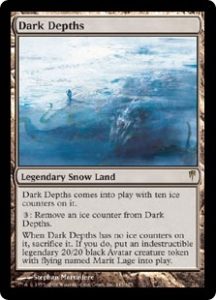
4 Thespian’s Stage
3 Dark Depths
Pretty straightforward as we are still wanting to find the combo in most games without having to invest too much time and resources into finding both pieces. Most lists only run 3 Dark Depths because honestly you just don’t want to see it too often in your opening hand and you play enough tutor effects to find it when needed. Because you have a great midrange strategy built into the deck, you’re not as reliant on the combo as other variants of Dark Depths decks.
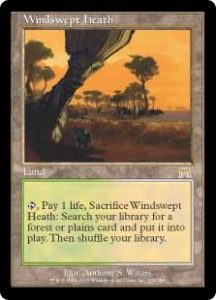

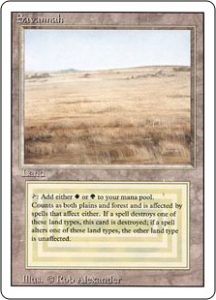


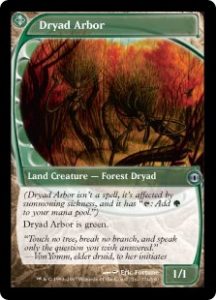
4 Windswepth Heath
1-2 Other G Fetchland [Verdant Catacombs, Wooded Foothills, Misty Rainforest]
2 Forest
1-2 Plains
2-3 Savannah
1 Dryad Arbor
This is the manabase you rely on to make sure you’re able to cast your spells in the early game even without Mox Diamond. Running the full 4 basics means you can even play the majority of your matches with a Wasteland-proof manabase which is a great feeling when you’re still able to cast Tomik through a Blood Moon. Windswept Health is your priority fetchland as it can get either basic, but after that it’s your choice when it comes to green fetchlands. I would say Misty Rainforest comes with the highest upside of being able to concede early to fast-combo decks and perhaps misleading your opponent into thinking you’re on a blue deck.





1 Karakas
1 Bojuka Bog
1-2 Horizon Canopy
1-2 Sejiri Steppe
1-3 Wasteland
This is the most common group of silver bullet lands run in GW Maverick. They all play their part to either win you the game or stop your opponent from winning the game. Although they are only 1-2 ofs in the deck, your multiple ways of accessing them at instant speed makes them quite easy to access.
Karakas is great at both keeping your Legendary threats alive while protecting you from opposing Griselbrands, Marit Lages, Thalias and other legendary threats. Bojuka Bog is fantastic against graveyard decks – especially when found at instant speed. Steppe gives you another way to protect your own creatures or get through a lone blocker like Baleful Strix. Horizon Canopy allows you to grind out some of the longer matches and pairs very nicely with Ramunap Excavator. Wasteland is mostly to be used aggressive to destroy opposing Karakas, Wastelands and Dark Depths.


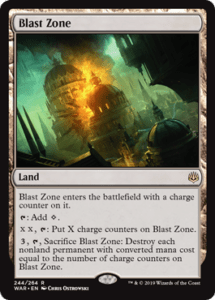
0-1 Maze of Ith
0-1 Ancient Tomb
0-1 Blast Zone
Maze of Ith is great at both keeping opposing creatures from getting damage through and giving your own creatures pseudo vigilance (you can untap your own creature at the end of combat after damage is dealt).
Lastly, Ancient Tomb. Tomb is a card that some pilots love and some don’t care for. Ancient Tomb is unique because it allows players to have the combo online a turn earlier than expected. It also allows you to combo off with both combo pieces in play and access a land and green mana for Crop Rotation. It also pays for Reclaimer’s ability by itself, leaving other mana open to cast further spells. Tomb also allows you to GSZ a little sooner than expected. With a Mox Diamond opening you are able to GSZ for 2 on T1, devasting against Storm if you’re landing a Gaddock Teeg on T1. Even playing Tomb on T2 or 3 means you’re hitting your bullets and beaters like Knight a turn ealier than expected.
Depending on your meta, I think Blast Zone is also a very powerful land to consider as it can deal with many popular threats in the format right now that GW might otherwise have a hard time dealing with.
The Creature Base:


4 Elvish Reclaimer
4 Knight of the Reliquary
These are just your best creatures for winning grindy matchups and setting up the combo all in one. The big difference is that Reclaimer’s lands come in tapped, so if you’re going for the combo over two turns, make sure you search for Thespian’s Stage first as it doesn’t matter if Depths comes in tapped after Stage is online. With a little patience, both of these threats can be online and out of bolt range from as early as T2. If your opponent has a strong plan against your combo, Reclaimer and Knight beats are your best route to victory.



4 Giver of Runes
2 Tomik, Distinguished Advokist
1 Sylvan Safekeeper
The magnificent 7, this set of creatures makes sure your creatures stay on the field and your pressure on your opponent’s life total isn’t strayed. Safekeeper could be argued as a flex-slot, however the ability to have protection via Green Sun’s Zenith that isn’t hit by summoning sickness makes Safekeeper’s role uniquely important. Tomik also helps make sure your manabase and combo stay intact for as long as you need it, while pressuring your opponent in the air.



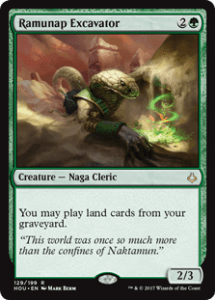

1 Gaddock Teeg
1 Qasali Pridemage / Knight of Autumn
1 Ramunap Excavator
1 Scavenging Ooze
Your silver bullet package. Here to make sure you have some amount of game against nearly every deck in your opening game. Teeg is great against control and combo, Scooze makes sure your opponents cannot use their graveyards as an effective resource and also helps you gain some life when it comes down to a race. Ramunap gives you resilience against the Wasteland decks, allows you to setup a Wasteland lock yourself and most importantly, allows you to use your graveyard as a resource – a second hand if you will. Qasali and Knight both have pros and cons which I’ve outlined in the FAQ section, however, I feel the ability to react at instant speed with Qasali is better in GW Depths than the flexibility of Knight. Never underestimate the power of exalted either. Although GB Depths has access to Abrupt Decay, GW’s ability to tutor removal for cards like Ensnaring Bridge or Blood Moon is the huge advantage GSZ adds to the deck.
This is also where you can bring some deck-building creativity into your 75. What’s your local meta like? Perhaps you want to run multiple Scavenging Ooze or both Qasali and Knight of Autumn. Green Sun’s Zenith and Crop Rotation really allow you to play around with the specific targets you want in your deck to hedge against the meta you know best.
The Non-Creature Spells:


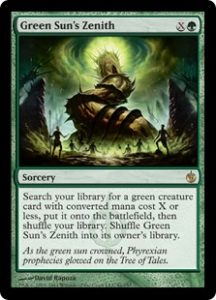


4 Crop Rotation
4 Green Sun’s Zenith
4 Mox Diamond
1-2 Sylvan Library
0-2 Path to Exile
For the most part, Green Sun’s Zenith is a delayed Crop Rotation 5-8 while still giving you outs against matchups where your silver bullets make a huge impact on the game. It also gives you a virtual 5 copies of your 1-of silver bullets so you can consistently find them. The full playsets of Crops, Zeniths and Diamonds allows you to not only have consistent opening turns, but the Crops and Zeniths allow you to mould your battlefield to find the right half of your deck if you’ve drawn into a hand that isn’t suited for the matchup.
Sylvan Library is an interesting choice, but with so many tutors in the deck, do you need the selection? Yes. Sylvan Library allows you to dig deep against the decks that don’t care if you’re at 20 life or 8 life and also gains you back card advantage if you’ve played out any number of Mox Diamond. Maindeck Path to Exile is really a meta choice but is becoming more and more common as players want maindeck removal for threats like Delver of Secrets, Dreadhorde Arcanist and Tarmogoyf, which can quickly get out of hand.
Sideboard Options:

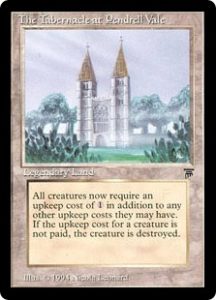
3-4 Path to Exile
It’s just the best way to deal with any threat from Delver to Griselbrand to an opposing Marit Lage. In this deck, Path is just a better option compared to Swords to Plowshares. Tabernacle is a great sideboard bullet to answer go-wide decks like UR Delver with Young Pyromancer or creature decks like Elves or Goblins. It’s also a narrow out to Empty the Warrens.


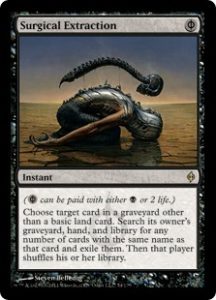
2-3 Thalia, Guardian of Thraben
2-3 Veil of Summer
2-3 Surgical Extraction
You really need to make sure you have some disruption against combo decks in G2 & 3 so these all add different axis of making sure you don’t make life easy for your opponent. Thalia may only be a speed bump for some decks but she’s a pest that applies pressure and can be protected in multiple ways including Karakas. Veil of Summer is great against hand-disruption decks, Storm (Tendril’s targets you) and even against a large amount of blue decks where being able to force your spells through countermagic can be backbreaking.
A small advantage I’ve found with Veil of Summer is that it can also give you a vital extra turn against Painter’s Servant decks as when Grindstone targets you, it will most likely be a blue permanent under Painter’s static ability. A small upside but something that has won me 2/2 matches I’ve played against Painer since Veil’s printing.
Surgical Extraction is well known for its ability to completely wreck opponents who rely on their graveyard to perform. Life from the Loam, Punishing Fire and Griselbrand are likely some of the most targeted cards in recent time. There is a strong argument between if you should run Leyline of the Void, Surgical Extraction or even Faerie Macabre as your sideboard graveyard hate which I wrote about in a previous article.



2 Force of Vigor
1 Collector Ouphe
1 Reclamation Sage
Reclamation Sage is seeing more play in sideboards over Qasali or Knight of Autumn because it’s much easier to cast through a Blood Moon effect. Collector Ouphe does hit your own Mox, however, this is only a small downside compared to the issues it will give your Death & Taxes, Bombermann, Storm or Eldrazi Post opponents (just to name a few). Force of Vigor is a great card to fight against the Blood Moon decks of the format and are also great against most of the decks Ouphe comes in against (not sure if it’s worth bringing in against Storm).
Why play Surgical Extraction over Leyline of the Void?


Being able to snipe removal from opponents can be a great strategy post-board. Taking Swords to Plowshares out of a Miracles player’s arsenal is huge when trying to stick a threat. I find many players mulligan too aggressively for a Leyline and can lead to some awful feel-bad moments. You need to evaluate if you’re going to be playing against a meta of decks that care about specific cards in their graveyard (Reanimator, Life from the Loam decks) or if you’re wanting a wider answer to shutting off their entire graveyard (Dredge, RUG Delver).
Why play Thalia, Guardian of Thraben over Deafening Silence?


It really comes down to what you believe is better for your meta and what feels better with your playstyle. Thalia is much easier to protect with Giver of Runes, Safekeeper, Karakas and Steppe and can also pressure your opponent, which is very important against combo archetypes. Deafening Silence comes down turn 1 which is vital against the decks you want it against and is much harder to remove from the board (Abrupt Decay, Assassin’s Trophy, Disenchant effects and bounce effects like Echoing Truth) compared to a creature. Right now with Wrenn in the format and Plague Engineer’s also running around, I can see why players may be opting for the enchantment over the 1 toughness legendary creature (sorry Thraben). The rise of Bomberman online and Depths decks in general has also caused an increase in the amount of Karakas being played, another effective pseudo-answer to Thalia.
When is Veil of Summer sided in?

Veil of Summer is a great card against disruptive decks or combo. If you’re expecting hand disruption or removal such as Abrupt Decay or Assassin’s Trophy post-board, Veil is a great way to counter your opponent’s plans and get ahead on card advantage. Veil is also fantastic against Storm’s win condition in Tendrils of Agony and can give you a vital extra turn against Painter’s Servant decks (as mentioned above).
GW Depths Coverage & Resources
Here you can find the Lands Discord channel with a section for GW / Naya Depths.
Just to break up the content, here’s a pretty sweet line I was lucky enough to catch showing the power of Turbo Depths in the matchup.
GW Depths 5-0 MTGO League | Rodrigo Togores
GW Depths 5-0 MTGO League | DougesOnTwitch
GW Depths MTGO League | DougesOnTwitch
GW Depths MTGO League | DougesOnTwitch
Dominic Harvey | GW Depths vs. UWR Mentor | SCG New Jersey
Michael Mapson | GW Depths vs. RUG Delver | SCG New Jersey
GW Depths Tips & Tricks
Maze of Ith

Maze isn’t only for defence. It can also be used to give your creatures psuedo-vigilance, allowing you to attack and then use a tap ability of Giver of Runes, Elvish Relclaimer or the most popular, Knight of the Reliquary.
After a creature has dealt damage, it’s still declared an attacking creature. This means you can attack with a Knight, deal damage and then at the end of combat, untap the Knight. You now have kept pressure on whilst being able to Wasteland your opponent or keep Knight open during your opponent’s turn.
Thespian’s Stage & Wasteland


If your opponent targets your Thespian’s Stage with Wasteland and there is a basic land on the battlefield, you can activate Stage, copy the basic land and then let the Wasteland’s activated ability resolve… well, kinda. Because Thespian’s Stage is now a basic land, Wasteland’s ability fizzles and you get to keep your manabase intact.
Dark Depths & Blood Moon


Under the latest ruling, if you play a Dark Depths with a Blood Moon effect already on the field, then the Depths enters as a Mountain without any counters on it. This means if you then destroy the Blood Moon (or Magus of the Moon) then the Dark Depths will instantly trigger.
Ramunap Excavator



If you’ve already used a Bojuka Boj or Sejiri Steppe once, you can squeeze out another activation by Wastelanding your own Bog or Steppe and then replaying it from your graveyard thanks to Ramunap, triggering them once more. This type of play is also useful with Karakas if you’re needing to get two Legendary creatures off the field in one turn OR hold up Karakas after using it once. Dryad Arbor & Ramunap also mean you have a chump blocker every turn, but with the current meta heavy on cheap removal, Wasteland and -x/-x effects, I don’t see this being too relevant right now.
Blast Zone & Thespian’s Stage


If you need to deal with a bunch of tokens and have some time on your side, you can copy Blast Zone with Thespian’s Stage which becomes a Blast Zone with no counters on it. This means you now have an answer to destroy all 0 CMC permanents on the field. Just look out for your own Mox Diamonds.
Giver of Runes

Just so players are clear on what some of the more popular colourless cards are in Legacy, here’s a list of things you can give protection with other than Karakas:
- Maze of Ith
- Barbarian Ring & Cabal Pit
- Kozilek’s Return
- Thespian’s Stage & Wasteland (if an opponent is trying to target your Dryad Arbor)
- Eldrazi such as Thought-Knot Seer
- Walking Ballista and other artifact creatures like Phyrexian Revoker
- The 2 damage from Sword of Fire & Ice
- Tokens produced by Karn, Scion of Urza
Purchase GW Depths Singles
The GreenSunsZenith.com is an affiliate with TCG Player and Cardhoarder! This means you can purchase cards in a safe and convenient manner through the site and help support the platform!
Conclusions:
GW Depths is a viable strategy in the current Legacy format and rewards pilots who adapt their 75 to beat their local or known metagame. You’re only going to become better with the deck through making the deck yours and playing with it continuously against a range of Legacy decks.
This and all content on the GreenSunsZenith.com is freely available content, however if you would like to contribute support, buy me a coffee via my Ko-Fi proifle page. Thanks for reading and please let me know if you’d like any further questions answered through the comments below.
